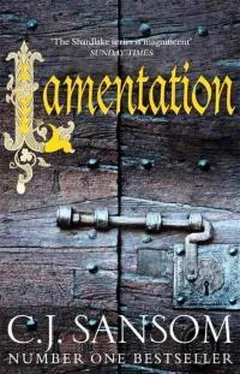If one looks at a timeline of political events in 1546, two things stand out. The first is that during the spring a major heresy hunt was ordered from within the court, targeting people who had denied the truth of transubstantiation. Transubstantiation is the doctrine which claims that during the ceremony of the Mass, the bread and wine are physically transformed into the actual blood and body of Christ; many Protestants, however, disagreed. It was over this point that, in 1539, Henry VIII drew a firm line. Under the ‘Act of Six Articles’ of that year, denial of transubstantiation, or ‘sacramentarianism’, was defined as heresy. One recantation was allowed; a refusal to recant, or a second offence, was punishable by burning alive.
In the 1546 heresy hunt the net spread widely, and those questioned by the council included the younger son of the Duke of Norfolk – who was interrogated about his presence at potentially subversive ‘preachings in the Queen’s chamber’ in Lent – and Henry’s courtier and friend George Blagge. The Queen was clearly under threat herself, as we shall see. The heresy hunt climaxed with the burning of Anne Askew and three others at Smithfield on the 16th of July. (The description of this in this book is based on the account by Foxe.) Meanwhile, though few even in Henry’s circle knew this, plans were being made for a papal emissary, Gurone Bertano, to be received by the King in London in August, to explore whether a rapprochement with Rome, after thirteen years of separation, was a possibility.
One gets the impression from this timeline that the ship of state which, steered by Henry, had for years veered wildly between support of traditional Catholic practice – but without the Pope – and a more thoroughgoing reform, set a firm course during the early months of 1546. With increasing speed it sailed towards the extirpation of Protestant heresy and the victory of those who favoured a traditionalist position – and possibly some agreement with the Pope.
Then suddenly, around the end of July, the ship of state turns round and steers, even faster, in exactly the opposite direction. The heresy hunt stopped dead in July, and some who had been convicted were quietly released, George Blagge being pardoned personally by the King.
In early August, Bertano arrived. He had his first and only meeting with the King on the 3rd. We do not know what was said, but the meeting was clearly unsuccessful. Afterwards, Henry wrote a letter to the Pope to which the Pontiff never replied. Bertano remained in a ‘safe house’ until late September, not seeing the King again, until word of his presence began to get out and he was ordered to go home.
DURING THE AUTUMN months Henry steered the metaphorical ship of state ever faster in a Protestant direction. He went on a Progress to Guildford, which was intended to be brief was but lengthened, probably because he fell seriously ill, and for over a month he stayed at Windsor on the way back. During this period, as was normal during Progresses, the Privy Council was split into two: those attending the King and those left in charge of business in London. Access to the King, as ever, was all-important, and the councillors Henry chose to be with him until he returned to London at the end of October were all either radical sympathizers or those who would bend to the wind, whichever way it blew.
IN NOVEMBER, BISHOP GARDINER, the leading conservative, found himself marginalized and denied access to the King. Then, in December, the other leading traditionalist, the Duke of Norfolk, and his son, the Earl of Surrey, were suddenly arrested and charged with treason. By now Henry’s health was deteriorating fast. He shut himself up at Whitehall Palace with his closest advisers, and in late December wrote a last Will, which appointed a council of sixteen to govern England until his nine-year-old son reached his majority. All the council members were either Protestants or centrists.
SPRING 1546 SAW, as well as the start of the heresy hunt, a complete about-turn in foreign policy. The two-year war against France had been a disastrous and costly failure. The English occupied Boulogne, but were besieged there, supplied by boat across the Channel, strongly opposed by French ships, at enormous cost. Despite his advisers’ entreaties during the winter of 1545-6, Henry refused to end the war.
Meantime, relations were uncertain with the Holy Roman Empire, which was at odds with its own Protestant subjects. England remained formally at war with Scotland, and the Pope continued to be an implacable foe. In March 1546 the ever warlike Henry finally accepted that this dreadful mess would have to be sorted out. Peace negotiations began with France, and a settlement was reached in June. Admiral d’Annebault, who had led the French fleet against England the year before, was invited to come to England as ambassador in August, and enormous celebrations were planned. This was surely a signal of Henry’s intent to make a lasting peace.
At the same time Henry negotiated a new treaty of peace with the other major Catholic power in Europe, the Holy Roman Empire. Peace with Scotland, too, was encompassed in the French treaty.
MOST ASTONISHING OF ALL was the arrival, via France, of the papal emissary Bertano. The previous year Pope Paul III had convened the Council of Trent, part of whose purpose was to see whether the Protestant powers could somehow be reconciled with the Holy See. This, I think, is the context for Bertano’s visit – to establish whether some arrangement could be made between England and the Pope, some formula to allow Henry to keep his Supreme Headship of the Church, which he genuinely believed had been awarded him by God, while making some friendly arrangement with the Pope. Theologically, however, the Royal Supremacy and the papal function were irreconcilable, and on this diplomatic front at least, Henry failed.
IF, AS THE TIMELINE SUGGESTS, March 1546 was the crucial date for changes in both domestic and foreign policy, what happened during that month? I think the answer lies in a development often overlooked – the collapse of Henry’s health.
It is impossible at this distance to be clear what was wrong exactly with Henry by the 1540s, but some things can be said confidently. The old idea that the King suffered from syphilis is long discredited – there is no evidence for this, and much against. At the core of Henry’s problems seems to have been lack of mobility. David Starkey has suggested in his Six Wives: The Queens of Henry VIII (2004) that in Henry’s jousting accident in 1528 he broke his left leg; it healed but left a piece of detached bone in his calf, which decayed and formed a large and painful ulcer. In any event, Henry gradually had to give up his former regime of very active exercise and, as the years passed, he became increasingly immobile. His portraits show growing obesity, especially in the period 1537 to 1540, during his late forties, between his marriages to Jane Seymour and Anne of Cleves.
By 1544, measurements for his armour showed a waistline of 54 inches; even a modest further weight gain might give a waistline of around 58 inches by 1546; even for a man of 6'2", this puts Henry at the outside edge of gross, morbid obesity. Why did a man who had so prided himself on his appearance allow this to happen? The most likely explanation is that his initial weight gain and immobility, especially given the Tudor elite’s diet of meat and sweetstuffs, would have made likely the development of type 2 diabetes, a disease not understood at the time. If this happened it would have added another element to the vicious cycle of immobility and weight gain, for Henry would have been constantly hungry and thirsty.
By 1546 it seems that walking any distance was difficult and painful for the King. He already sometimes used a ‘tram’ (a type of wheelchair) to get around the palaces, and had a ‘device’ to get him up and down stairs. And his gross obesity and immobility would have made him prone to yet another problem, deep-vein thrombosis in his legs, both of which were now described as ulcerated (a condition consistent with diabetes). Blood clots would form in the legs, then could become detached and travel to the lungs (to trigger a pulmonary embolism). If the clot can dissolve, a patient can survive, but otherwise dies. The descriptions of Henry’s medical crises from 1541 seem consistent with a series of pulmonary embolisms, the last of which killed him in January 1547, although he would also be liable to strokes or heart attacks – all his organs would have been under tremendous strain.
Читать дальше








![К Сэнсом - Стенание [другой перевод]](/books/432043/k-sensom-stenanie-drugoj-perevod-thumb.webp)
